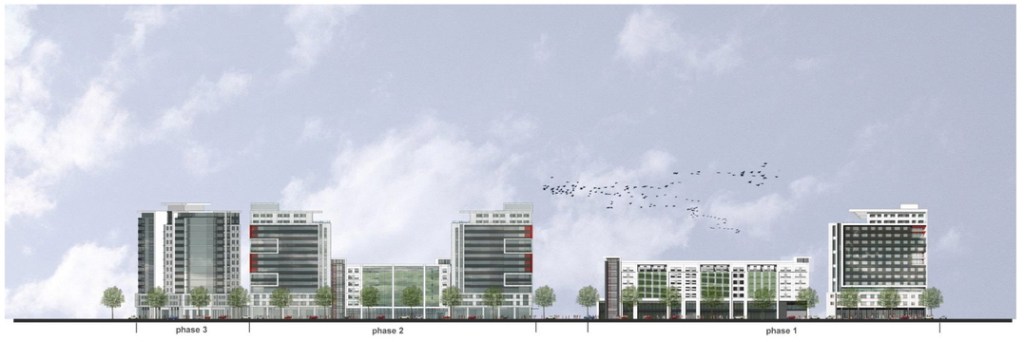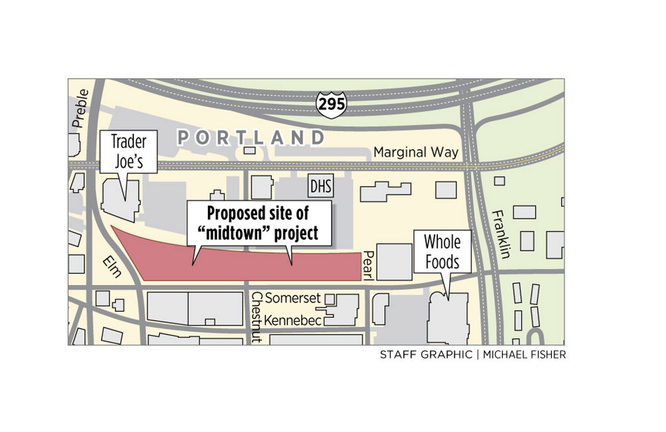While not a typical factor in city development projects, wind has emerged as a major point of contention in the debate over a massive mixed-use complex proposed for Portland’s Bayside neighborhood.
The Miami-based Federated Cos. is planning to build up to four residential towers and a parking garage on roughly 3.25 acres of vacant city-owned land on Somerset Street.
The Planning Board will hold a formal public hearing about the project on Dec. 10, at which point the board could take a final vote.
The project – known as “midtown” – has already received a $9.5 million subsidy from the city for a parking garage. The City Council also increased height limits over public opposition to move the project forward.
The wind issues are tied to the building height, and the developer is tweaking the building design to address concerns about wind speeds.
A 165-foot-tall building essentially functions like a sail on a sailboat, capturing the wind and driving it downward and around structures at speeds greater than would otherwise be experienced in an open area.
“The higher you go, the faster the wind” effect, said Planning Board Chairwoman Carol Morrissette.
Peter Monro, a landscape architect and co-founder of Keep Portland Livable, which opposes the high-rise complex, said he fears it will create unsafe conditions on the ground, especially during the winter, because it will be so much taller than the surrounding buildings.
“We think this is a bad development. It’s a terrible design and it sets a bad precedent for the city,” said Monro, whose group has hired an attorney to help oppose the project.
City staff and Planning Board members agree that wind speeds are an area of concern, but not to the extent portrayed by Monro.
“We’re pretty confident the wind speeds can be addressed,” said Jeff Levine, the director of the city’s planning and urban development department.
Federated Cos. commissioned a wind study by Rowan Williams Davies & Irwin Inc., a Canadian consulting firm with an office in the developer’s hometown of Miami. The firm says it has conducted more than 2,000 wind model studies and has created its own software to help try to predict post-development wind patterns.
The study only looked at the first phase of the project – a 165-foot residential tower with first-floor retail space and a six-story parking garage. It did not examine other wind-related issues, such as snowdrifts, air quality and door pressure.
RWDI concluded that wind impacts could create uncomfortable ground-level conditions but would not be dangerous to pedestrians. The areas most affected will likely be a residential courtyard and a pathway – or mews – between the residential tower and the parking garage.
“Wind speeds at most outdoor amenity spaces, either at grade or above grade, are predicted to be higher than desired for passive activities, such as sitting,” the report concludes. “No dangerous wind speeds … are predicted at any (of the) pedestrian areas.”
The firm noted that the building’s facade is broken up by terraces and step-backs, which help reduce wind speeds at ground level. However, that design could make it uncomfortable for residents on those terraces, especially during the summer, the report states.
The firm analyzed wind patterns recorded at the Portland International Jetport between 1973 to 2013 to come to its conclusions.
Not surprisingly, the most fierce and biting winds come from the northeast during the winter months. Those prevailing winds flow over Back Cove, Interstate 295 and over low-lying buildings on Marginal Way.
“(The winds will) hit these buildings pretty much at full force and full face,” Monro said.
But Greg Shinberg, a local representative for the developer, said cold, blustery winds are a fact of life here during the winter.
“It’s Maine. It’s winter. That’s just how it works here,” Shinberg said. “Most people are not going to be sitting out there during the winter.”
Winds are less of an issue during the summer, when wind speeds are slower and the weather is warmer. Summer winds primarily come out of the south-southwest, which means they are impeded by taller buildings on the peninsula.
Wind speeds between 19 and 27 mph are generally considered uncomfortable for walking, according to the report. Anytime the wind reaches 27 mph or higher, the current is considered dangerous, the report states.
While the study concludes that the area will not reach those dangerous levels after it is developed, Monro criticized the report for not backing up that assertion with numbers.
Morrissette said she was comfortable with how the firm reached its conclusions.
“From what I understand from … reading the report is that we’re borderline,” Morrissette said on the wind impacts. “We have to figure out where the issues are in reality when it gets built.”
Shinberg noted that the project designers, CBT Architects of Boston, have experience dealing with wind issues in Boston, where they have designed 50- and 60-story buildings.
“These are not dangerous winds,” Shinberg said. Noting that if wind speeds are too intense, then no one will want to live there, he said, “It’s clearly in our best interest to do everything we can to mitigate the wind.”
Shinberg said architects are working on redesigning portions of the building’s exterior to further reduce wind. Those revised plans will be submitted before the Planning Board’s Dec. 10 public hearing on the project. He could not provide an estimate for how much the alterations would cost.
The wind study also includes a list of recommendations to further reduce the impact of the wind. Those recommendations include vertical and horizontal wind screens and evergreen plantings.
The city is asking the developer to draft a wind management plan before the board votes. The developer will then be asked to monitor wind speeds after the first tower is built and implement changes as needed.
“We’d like to make sure the results of the study play out on the ground,” Levine said. “We just want to make sure it’s worth it.”
Randy Billings can be contacted at 791-6346 or at:rbillings@pressherald.comTwitter: @randybillings
Send questions/comments to the editors.




